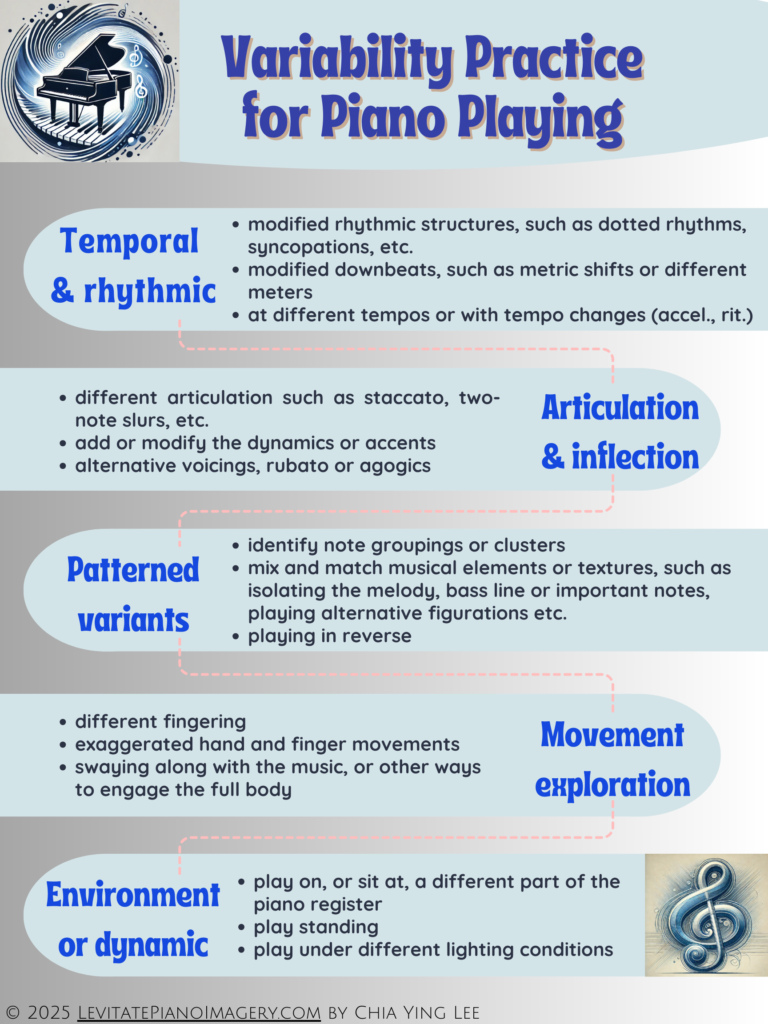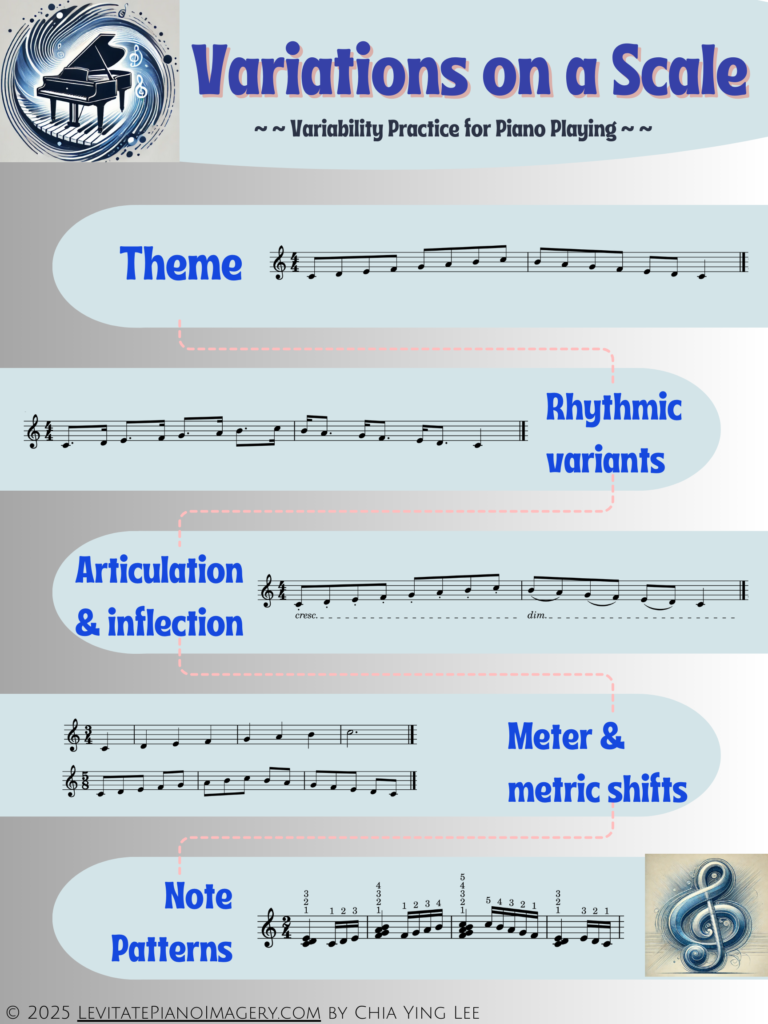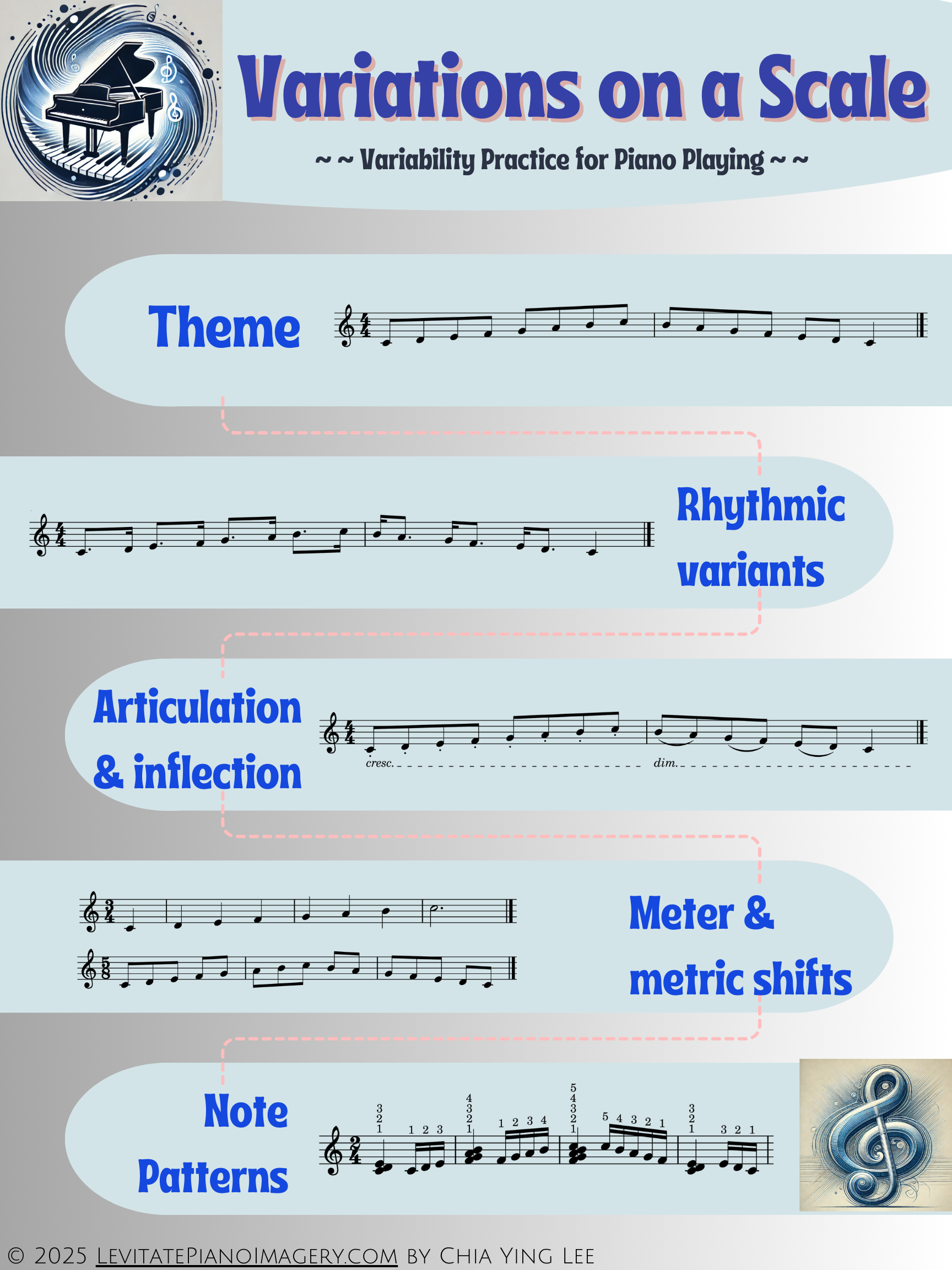“Practice in rhythms!”
“Practice it staccato!”
“Practice alternative interpretations!”
Three mantras from three different teachers of mine. These are strategies of practicing a musical passage by playing it in a variety of modified rhythmic patterns, articulation and inflections. Not coincidentally, they are all predicated on a common idea, the concept of variability training.
The aggregated wisdom of centuries of piano pedagogy has already discovered variability training as a core practice technique. Additionally, motor learning research has confirmed that variability training does indeed benefit motor skill acquisition: it improves how well the learnt movements are retained in memory, and the learner is better able to generalize the skills to novel patterns that she has not encountered before.1 The variability introduced into a training regimen may include
- different environmental conditions or dynamic interactions [Wulf & Schmidt (1997)]
- a deliberate exploration of the range of movement space [Dhawale, Smith, Ölveczky (2017)]
- temporal variation of the movements and movement outcome [Furuya & Yokota (2018)]
Variability Training in Piano Practicing
If you aren’t already using variability practice, or would like more ideas, here is a cheat sheet with examples of variations that you can use. (Click on the image to enlarge.)

The first three categories, temporal & rhythmic, articulation & inflection, as well as patterned variants, are all musical in nature. Besides engaging the learner’s audiation and auditory imagery in variegated ways, musical variants also encourage the learner to explore a broader range of movement space by changing the musical content of the passage to be played. Movement (spatial) exploration creates a reinforcement learning process2 that expands the learner’s range of motion beyond her comfort zone, and this enables her to discover new movements and different muscular coordination that are more effective than her existing motions [Dhawale, Smith, Ölveczky (2017)].
As a general tool for motor learning, movement exploration can also be non-music related. Therefore, exaggerated or full-body movement, switching up familiar elements in the learning environment, incorporating dynamic interactions with companion musicians, and inventing games out of the task, are all valid ways to incorporate variability into the learning process.
For a concrete application of musical variability, I present to you, Variations on a Scale.

Functional Variability
Variability training is meant to develop the learner’s adaptability to deviations and ability to exhibit functional variability.
I remember a few instances of performances where I was feeling a huge struggle while playing the piece, my hands felt all wrong, my mind was wrestling to hold everything together, and yet I was told afterwards that it was my best playing yet.
Although we might wish that we can play the exact same passage with the exact same perfection every time, the reality of being human is that variability of movement execution is inevitable. Nonetheless, despite this variability, it is still possible to achieve a successful outcome. This is the notion of functional variability: subtle and subconscious motor corrections that are made in real time to compensate for the variability in movement execution, such that the end result is still a successful task outcome. [Müller & Loosch (1999)]
Although functional variability is an inconvenient fact of life, the adaptibility inherent to functional variability is actually a desirable trait. Say, you’ve hit a wrong note unexpectedly. Without functional variability, the erroneous action throws off the motor movements that you’ve practiced so consistently, and you are now unable to recover from the initial error. Whereas with functional variability, you make corrective movements to compensate for the erroneous action, and are able to continue on with the piece. If done properly, variability training is meant to develop the learner’s adaptability to deviations and ability to exhibit functional variability.
The Neuromuscular Basis for Variation Training
On a neuromuscular level, muscular virtuosity is characterized by higher precision and maximum movement speed being achieved by lower muscular activity. Think of the highly efficient hand and finger movements exhibited by great pianists playing virtuosic pieces. Thanks to the neuroplasticity of our sensorimotor system, the appropriate type of practice enables us to reorganize our hand’s muscle coordination to achieve muscular virtuosity. This is shown in [Furuya & Yokota (2018)], where, using miniature electrodes to measure muscle activity in the pianists’ hands, temporal variability when practicing an excerpt from Chopin Etude Op. 10 No. 2, resulted in a dynamic reorganization of the pianists’ hand coordination!
With some creativity, variability practice can be adopted to any piece you’re learning. With experience, you will begin to find the appropriate variants to try for any given piece or passage. As a gentle reminder about autonomy in the learning environment: it is important for the choice of variants to be learner-led, and that the variants be practiced with deliberateness and volition. Happy Variability Practicing!
Footnotes
- Variation training is not for the impatient learner. While research consistently points to deeper learning with better skill retention and generalization, it is not necessarily true that variability training brings about faster learning [He et al. (2016)]. ↩︎
- If you’re familiar with the exploration-exploitation dichotomy of reinforcement learning theory, exploitation is akin to staying within your comfort zone and finding the locally optimal movements for playing a piece, from within the limited set of movements you are already familiar with. By embarking on an exploration phase, you expand the boundaries to unfamiliar movements so that you eventually find better and globally optimal solutions. ↩︎
References
Müller, H., & Loosch, E. (1999). Functional variability and an equifinal
path of movement during targeted throwing. Journal of Human Movement Studies, 36, 103–126.
Wulf, G., & Schmidt, R. A. (1997). Variability of practice and implicit motor learning. Journal of Experimental Psychology: Learning, Memory, and Cognition, 23, 987–1006.
Furuya, S., & Yokota, S. (2018). Temporal exploration in sequential movements shapes efficient neuromuscular control. J Neurophysiol. 2018;120(1):196–210. 10.1152/jn.00922.2017
Dhawale AK, Smith MA, Ölveczky BP. The role of variability in motor learning. Annu Rev Neurosci 40: 479–498, 2017. doi:10.1146/annurev-neuro-072116-031548.
He K, Liang Y, Abdollahi F, Fisher Bittmann M, Kording K, Wei K (2016) The Statistical Determinants of the Speed of Motor Learning. PLoS Comput Biol 12(9): e1005023. https://doi.org/10.1371/journal.pcbi.1005023


Leave a Reply